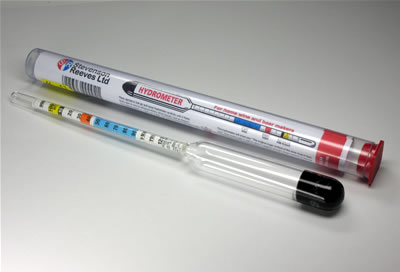Using a Hydrometer
A hydrometer is a useful tool in the hands of a brewer and allows you to obtain the gravity levels (density) between pure water and water with sugar dissolved in it by flotation and you also determine the alcohol percentage at the end of fermentation.
During the brewing process yeast is added to malt and some other fermentable ingredients and during fermentation the yeast organisms eat the malts and sugars and produce ethanol. The hydrometer is used to gauge the fermentation progress by measuring one aspect of it, attenuation. Attenuation is the conversion of sugar to ethanol by the yeast. Water has a specific gravity of 1.000. Beers typically have a final gravity between 1.015 and 1.005. Champagnes and meads can have gravities less than 1.000, because of the large percentage of ethyl alcohol, which is less than 1. Hydrometer readings are standardized to 15°C.
Beginning brewers often make the mistake of checking the gravity too frequently. Every time you open the fermenter, you are risking infection from airborne microbes. Check the gravity when you are ready to pitch the yeast, then leave it alone until the bubbling in the airlock stops. Checking the gravity in-between will not change anything except to possibly contaminate it. Also, always remove a sample of the wort to test it, don’t stick the hydrometer into the whole batch. Use a sanitized siphon, Wine Thief or draw from the tap to withdraw a sample of the wort into a test tube and float the hydrometer in that, by doing that there is less chance of infection. You can drink the sample to see how the fermentation is coming along; it should taste like beer even though it may taste a bit yeasty.
It is good practice to record your SG (starting gravity) as well as your FG (final gravity) in order to obtain the alcohol percentage as well as for future use if you decide to brew that beer or style again as then you will have a more familiar idea when your brew will be finished.
The steps to follow:
1. Create your wort; all your fermentable’s with appropriate amount of water in to your fermenter
2. Record your SG; depending how much sugar or malt you have added will determine the SG.
3. Pitch yeast
4. Seal up and let brew ferment until airlock has finished bubbling.
5. Draw a sample into test tube and record FG
6. Re test again over 2-3 day period and if FG has not changed then your brew is ready to bottle or keg.
Calculating the alcohol percentage is easy if you follow the steps above:
Minus your SG from your FG and divide it by 7.36 and that will give you your alcohol percentage.
SG – FG
_________
7.36 = ALC%
For example:
SG: 1045
FG: 1010
1045 – 1010 = 35 / 7.36 = 4.75
It’s that simple.
